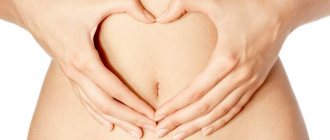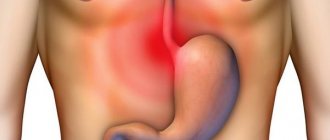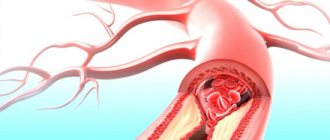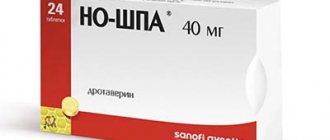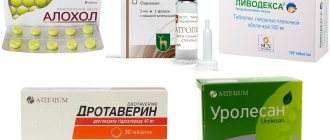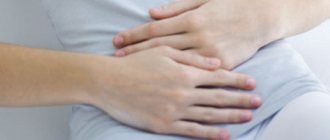Medicines
27.10.2018
Many women face the problem of abdominal pain during the menstrual cycle. For some, the feeling of painful periods is tolerable, but for others it is not. What can be done in such a situation, what is the best remedy for heavy discharge, what is the best pill for pain during menstruation? Let's try to figure it all out today by choosing a truly effective remedy for a painful menstrual cycle.
Causes of pain
Unpleasant sensations in the lower abdomen in women before and during menstruation are in most cases associated with increased contraction of the muscular walls of the uterus. This is a normal physiological process associated with the separation and removal of spent endometrium. During this period, a lot of mucus and blood accumulate in the cavity, the organ swells, hormonal changes lead to fluid retention in the body, causing mood swings, weakness, and dizziness. On critical days, you should not actively engage in sports, or perform complex yoga exercises and stay in the cold for a long time.
Pain during menstruation can haunt a girl from the beginning of puberty - in these cases they speak of primary algodismenorrhea. It is provoked by individual characteristics: low pain threshold, structural defects of the uterus, lack of vitamins and minerals. Sometimes painful periods can hide a low-grade inflammatory process.
If the pain first appeared not in adolescence, but in a fairly mature age, it is of a secondary nature, one should suspect disturbances in the functioning or organic changes of the genital organs: the development of adhesions, cysts, fibroids, endometrial dysplasia.
Taking painkillers during menstruation in large quantities is not recommended. Any medications have many side effects, and can also suppress the symptoms of existing diseases. And, of course, pills do not solve the problem of algodismenorrhea, but only dull the symptoms. Therefore, it is much more useful to undergo a thorough examination and, having found out the exact origin of the pathology, begin its treatment. A painkiller is a first aid to relieve suffering.
Causes and types of menstrual pain
Pain during menstruation has a different character: pulling, tingling, spasmodic, aching. Even if these symptoms are not clearly expressed, sometimes you have to endure them for quite a long time (in 50% of cases, the sensation of pain begins to be noted 3-4 days before menstruation and ends on the last day of menstruation).
There are three stages of pain during menstruation, which are based on the accompanying symptoms and intensity of sensations:
- first stage (minor pain in the lower abdomen, which does not interfere with the usual way of life);
- second stage (the intensity of pain begins to increase, body temperature decreases slightly, slight nausea appears, and instability of the psycho-emotional state is noted, a tendency to depression and severe PMS);
- third stage (during pain during menstruation, a feeling of discomfort begins to spread both to the lower abdomen and to the lower back, an increase in temperature, the appearance of vomiting and nausea, a depressed and depressed state, general weakness are possible; such symptoms may indicate gynecological diseases).
The most common cause of pain is primary dysmenorrhea. Menstruation occurs in a complicated form due to a general disruption of the body or due to the influence of external negative factors:
- using the IUD as a contraceptive;
- hormonal imbalance;
- restoration of menstruation after childbirth;
- previous termination of pregnancy;
- lack of minerals and nutrients in the body;
- lack of regular sexual intercourse;
- genetic predisposition to pain during menstruation;
- improper nutrition.
All these factors cause quickly passing and minor pain.
However, if the situation is severe and even special painkillers during menstruation do not help cope, then most likely the woman has secondary dysmenorrhea, signaling a disruption in the body’s functioning.
Painkillers during menstruation, which are aimed at correcting the pain syndrome, can help even in cases where there is a serious problem (from those listed above). But this is only a short-term effect, since the disease, which is the main cause, is not treated.
What injections can you give?
Moderate pain syndrome is quite amenable to the effects of conventional tablet analgesics or antispasmodics, but there are situations when a woman’s physical condition deteriorates so much at the onset of menstruation that she is unable to bear the pain in her legs. In case of acute sensations, oral medications are often powerless, since their absorption into the blood and the onset of action takes a certain time, and when severe pain develops, a more significant effect is necessary. In such cases, injectable solutions of analgesics that are administered intramuscularly are more suitable. An injection should also be preferred if you have existing diseases of the gastrointestinal tract, since the tablets irritate the gastric mucosa and can cause exacerbation of gastritis or pancreatitis.
The type of injections used must be approved by the doctor. It is permissible only for women with medical skills to provide such assistance to themselves; for others, only a paramedic, nurse or doctor can administer the drug.
Medicines that can be injected for painful periods have an analgesic and mild anti-inflammatory effect. The following drugs are used:
- Novocaine;
- Ledocaine;
- Baralgin;
- Ketanov;
- Diclofenac;
- Analgin.
The doctor may recommend other good remedies. An anesthetic injection will be most effective if given before bedtime, preferably before development or at the initial signs of malaise.
It should be remembered that anesthetic drugs are contraindicated when drinking alcohol and are incompatible with some other medications.
Types of pills for pain during menstruation
How to get rid of PMS? Painkiller pills used during and before menstruation vary not only in price, but also in strength, and therefore in direction. The most common analgesics are of moderate effect. Such tablets are recommended even in adolescence, because the negative effects of painkillers on the body are minimal. But even these drugs are strictly forbidden to be taken more than 3 times in 24 hours. For adolescents, the daily dose is limited to one tablet. Let's look at the most common moderate-impact analgesics:
- Ibuprofen;
- Diclofenac;
- Ketoprofen;
- Indomethacin;
- Piroxicam;
- Analgin;
- Tamipul;
- Nise;
- No-Shpa;
- Nurofen.
It is worth noting that you should not expect instant relief from these tablets. The active components begin to act no earlier than 15 minutes after taking the drug, and some tablets for abdominal pain during menstruation even have a cumulative effect.
Many experts are confident that the effect of regular Paracetamol is similar to many painkillers that eliminate discomfort during PMS.
The best result is achieved as a result of a course of taking tablets, which, in turn, should not exceed 5 days.
It is not recommended to repeat courses of the drug very often. These pills should be taken with caution by girls in adolescence.
If pain occurs during menstruation, Paracetamol tablets can only be taken 3 times, one tablet per day.
The strength of the effects of pills for pain during menstruation directly depends on the chemical composition of the drugs. Painkillers in capsule form are divided into groups.
Antispasmodics
The principle of action of painkillers in the form of tablets is based on the elimination of spasm and pain. The speed of exposure directly depends on the “generation” to which the chemical composition of the capsules belongs. The best painkillers for menstruation in this category are recognized:
Papaverine
The regimen for taking the painkiller is described in detail in the instructions. In most cases, it is recommended to take 1 tablet 3 times a day. The active components of this powerful drug help eliminate tone in muscle tissue. The pain does not go away completely after taking the pill, but it becomes barely noticeable, and severe cramps disappear.
Buscopan
Tablet regimen: in most cases, the therapist prescribes one or two tablets 5 times a day. The complex of painkiller components was created specifically to relieve tone and eliminate colic and pain that appear in the lower abdomen. Buscopan is recognized as one of the safest antispasmodic drugs during menstruation, because the tablets are absorbed into the gastrointestinal tract in minimal quantities, which means that the harmful effects on the organs of the digestive system are minimal.
Drotaverine
The dosage regimen is identical to Buscopan. Due to their dilating effect on blood vessels, the tablets are recommended for relieving not only menstrual pain, but also for eliminating discomfort during the postpartum period and during pregnancy. The drug has the longest lasting effect and is able to relieve pain in the shortest possible time.
No-shpa
One of the most loved pills by women for pain during menstruation. In terms of its chemical composition, the medicine is an analogue of Drotaverine, but there are no side effects during administration. Experts say that Noshpa can be taken up to 6 tablets per day.
Analgesics
They are distinguished by their ability to instantly relieve pain. Let's look at the list of the most popular painkillers for menstruation from a number of analgesics. These include:
- Spazmalgin;
- Novalgin;
- Baralgin;
- Analgin;
- Minalgin;
- Peretin.
Due to the complex effect on all body systems, doctors do not recommend taking analgesic drugs more than once a day.
Analgesics can also help in the fight against aching and nagging premenstrual pain, as well as eliminate inflammatory processes in the muscles.
Nonsteroidal tablets for pain during PMS
These painkillers not only relieve pain, but also have an anti-inflammatory effect. Most often, experts prescribe non-steroidal tablets in combination with antispasmodics. These pills for menstrual pain are not only effective, but also affordable and low in price. Let's consider the most common non-steroidal drugs:
Aspirin
The tablets have a cumulative property and smoothly relieve pain. Therapists prescribe 2 tablets 4 times a day. On average, the price category of a medicine varies from 80 rubles.
Paracetamol
Doctors do not recommend taking pills more than 4 times a day. The price of painkillers varies between 6-20 rubles. for 10 pieces.
Ibuprofen
The frequency of taking tablets should not exceed 6 times a day. The cost of the drug is 15 rubles. for 20 tablets.
What medications can you take?
Painkillers during menstruation should be chosen carefully, carefully studying contraindications to the use of the drug. The main principle of choosing a medicine should not be the cost or popularity of the drug, but its mechanism of action.
In some cases, with severe pain, analgesics do not bring the desired result, but an ordinary antispasmodic helps well. Which painkillers to choose depends on the nature and intensity of the sensations, state of health, and associated disorders.
The list of painkillers includes drugs that differ in pharmacological properties.
Range of drugs
If a woman chooses pain pills that are suitable for her period, she should pay special attention to the mechanism of action of the drugs. For example, there are medications that can relieve only mild or moderate pain, while others, on the contrary, are suitable only for severe and prolonged syndrome.
There is another important point: taking pills for abdominal pain during menstruation, if the symptom is weak, strong medications; when the sensations are unbearable, it will be difficult to choose a remedy to relieve them, since the body will develop a habit and a certain reaction. In this case, you will need to resort to injections. Therefore, it is worth choosing exactly those pills for pain during menstruation in the abdomen that help, and are not the strongest.
Conventional analgesics are especially popular. They are preferred by the majority of women who suffer from dysmenorrhea. They give a weak effect, but it is enough to relieve discomfort.
Assortment of painkillers. Source: darudar.org
In the case of drugs of the opioid group, you must be very careful, since they not only contain narcotic substances, but are also addictive. It is strictly forbidden to take such tablets for abdominal pain due to menstruation without medical prescription and supervision, as well as to deviate from the recommended dose.
Non-steroidal painkillers are considered the most acceptable in this situation. Their main advantage is the ability to act specifically on the pathological focus, as well as provide a long-term analgesic effect.
Sometimes pain occurs due to contraction of the muscles of the uterus, and then it is localized in the lower abdomen. Antispasmodics are used to relieve them. The drugs relieve excessive contraction of smooth muscles caused by an increased amount of prostaglandins produced. If you strictly follow the instructions for use, you can drink them yourself.
The list contains inexpensive painkillers for menstruation:
- Analgin – 22 rubles;
- Paracetamol – 3 rubles;
- Ibuprofen – 14 rubles;
- Drotaverine – 14 rubles;
- Piroxicam – 40 rubles;
- Ketanov - 57 rubles.
All of these pills for pain during menstruation can be taken in each cycle if a woman experiences discomfort and unpleasant sensations associated with the constant progression of this syndrome. Some women are helped by No-spa, which has a natural composition and a price of 65 rubles.
Antispasmodics
To get rid of pain during menstruation, there is a practice of using antispasmodic drugs. Their action is to relax the smooth fibers of the muscles. As a result, convulsive contractions and excessive contractions of all muscle tissues are eliminated. For algodismenorrhea, such drugs have a direct therapeutic effect. The tone of the walls of the uterus and surrounding tissues decreases, the blood vessels dilate - the spasm is eliminated, the pain subsides.
The most common medications in this area are:
- No-Shpa. A Hungarian drug whose effectiveness has been tested for decades. It is characterized by many as the best remedy for pain and heaviness in the abdomen during menstruation. It is recommended to take it 1-2 days before the start of your critical days. The dosage depends on the intensity of the symptoms. The instructions advise taking 1-2 tablets three times a day. The drug No-Shpa Forte contains a remote dose of the active substance.
- Drotaverine. Many people call it the “Russian No-Spa” and this is absolutely fair - after all, these medicines are identical in composition. The only difference is the price. The action and dosage of Drotaverine is the same as its famous analogue.
- Papaverine. The effectiveness of this medicine is close to Drotaverine; the drug is taken 3-5 times a day until the painful symptoms subside. There are release forms in capsules and suppositories for topical use.
- Spasmalgon. This medication has a complex therapeutic effect, since in addition to the antispasmodic it contains an analgesic. It is recommended to take it for pain of moderate to severe intensity. You should start when the unpleasant sensations have not yet manifested themselves in full force. Recommended dosage: 1-3 tablets per day.
- Galidor. A remedy for relaxing the uterine muscles, containing an additional sedative component. Good for severe irritability and anxiety caused by severe pain.
- Buskopan. A medicine based on hyoscine butyl bromide is one of the drugs of choice for painful menstruation. When using, you must follow the dosage: you can take 2-4 tablets per day.
Antispasmodics for pain during menstruation can be used either alone or in combination with analgesics. Spazmalgon and its analogues are more convenient. In this case, not only the sensations caused by muscle contraction are stopped, but also the sensitivity of pain receptors. In the absence of a complex drug, you can combine Analgin and No-Shpa, if there are no contraindications to this.
Antispasmodics should be used with caution in case of low blood pressure, glaucoma and cerebrovascular accidents, as they affect vascular tone. They are also contraindicated in case of existing liver failure, hepatosis, or acute kidney inflammation.
Effect of painkillers during menstruation
To eliminate pain during menstruation, painkillers are used, which include:
- Analgesics . They have an analgesic and antipyretic effect, eliminate feelings of fatigue, and reduce drowsiness. Disadvantage: short-term effect. For best effect, it is recommended to use it in combination with antispasmodic medications.
- Antispasmodics . They increase blood flow to the uterus and dilate the pelvic vessels. They help get rid of mild abdominal pain and cramps, but do not have a positive effect during heavy menstruation.
- Non-steroidal anti-inflammatory drugs. Effectively eliminate inflammatory processes, uterine spasms and severe menstrual pain. Drugs in this group are recommended for adolescents, since they have a minimum of contraindications and normalize the level of sex hormones. To achieve maximum results, you can start taking the pills the day before your period starts.
Painkillers are the most reliable way to get rid of menstrual pain
If painkillers do not have a positive effect, and while taking them the pain intensifies and copious bright red discharge appears, immediately call a doctor and get examined.
Analgesics
Pain-reducing drugs based on analgin have remained popular for many years, as they have a strong therapeutic effect, eliminating attacks of varying intensity. Analgin, whose generic name sounds like metamizole, inhibits the sensitivity of pain receptors and reduces the transmission of nerve impulses to the brain.
There are a lot of complaints about Analgin and its analogues. Like any effective medicine, if used incorrectly, it can cause severe side effects. It is not recommended for children and adolescents, people suffering from hematopoiesis disorders, or diseases of the digestive tract.
When using analgesics, it is necessary to monitor your well-being: the appearance of severe dizziness, nausea, skin rash or itching may be a consequence of intolerance. In such cases, a replacement is selected.
Analgin is contained in the following popular painkillers:
- Baralgin;
- Minalgin;
- Novalgin;
- Ronaldin;
- Andipal.
The dosage of drugs with metamizole involves the use of no more than 3-4 tablets, it cannot be increased. If the analgesic does not work, the pain may not be due to menstruation.
There are dozens of drugs based on this active substance. They all differ in cost, manufacturer’s name, dosage of metamizole in capsules and tablets. Which remedy will help a particular woman get rid of pain depends on individual susceptibility. Often the same remedy quickly eliminates symptoms in one case, but in another it turns out to be ineffective.
For teenagers
In some cases, painkillers may be needed during a teenager's period if the girl has primary dysmenorrhea. Almost always, in young patients, when the discharge is at the menarche stage, there is severe pain. To get rid of the syndrome, you should start taking the medicine 2-3 days before the start of menstruation.
The safest pills for painful periods in girls are those that contain ibuprofen. The declared therapeutic effect occurs in a short time, and within 15 minutes the patient will feel a decrease in uncomfortable symptoms. If a teenager needs painkillers during menstruation, the names of the drugs are as follows: Ibuprofen, Naproxen, Ketoprofen, Tamipul, Indomethacin, Diclofenac, Piroxicam.
Medicines are not always available in the home medicine cabinet at the right time. In their absence, to relieve pain for a while, you can take a Paracetamol tablet. You can do one to three doses per day. Doctors also advise taking paracetamol about two days before the onset of discharge, as well as three days during menstruation.
The average course of therapy is five days. It is also worth noting that the final days of menstruation are much easier to bear, so discomfort and pain can be endured so that the body does not receive an overdose of the medication. If Paracetamol is ineffective, you can take Analgin (no more than three tablets per day).
Regardless of what forces a woman to take the drug, it is recommended to consult a gynecologist before starting therapy. The doctor, after communicating with the patient, will be able to determine which remedy suits her best, prescribe the dose and duration of treatment.
Nonsteroidal drugs
Nonsteroidal anti-inflammatory drugs or NSAIDs have an effect similar to analgesics - they reduce the sensitivity of nerve endings to pain, but at the same time they are antipyretics - they eliminate inflammatory reactions and regulate body temperature. A similar effect is necessary for pain during menstruation caused by various pathologies of the reproductive system, or for algomenorrhea combined with colds or other inflammatory diseases.
The advantage of non-steroidal drugs is their low toxicity and the ability to use them without any consequences for the body. For this reason, the drugs are approved for the treatment of algodismenorrhea in adolescence and for women suffering from any disorders in the functioning of internal organs. Among the drugs in this direction are:
- Ibuprofen;
- Nurofen;
- Ibuklin;
- Ketorolac and its analogs: Ketanov, Ketoprofen;
- Diclofenac;
- Naproxen;
- Paracetamol;
- Piroxicam;
- Indomethacin.
The best drugs are those containing two components at once, for example, Ibuklin based on paracetamol and ibuprofen.
The well-known and popular NSAID Aspirin also has a pronounced anti-inflammatory and analgesic effect, however, it should not be used during menstruation. This medicine thins the blood, which can cause massive uterine bleeding in women who naturally have low coagulability. Another aspirin-based NSAID is Citramon, which is also undesirable to drink on menstrual periods.
Other non-steroidal drugs should also not be taken uncontrolled - the daily dosage for severe pain should not exceed 4-5 tablets.
Causes of pain during menstruation
In order to choose the right analgesic, it is necessary to understand the “etymology” of pain. Discomfortable sensations shortly before menstruation and in the first days of menstruation are a physiological phenomenon. Most girls of reproductive age note that the lower abdomen not only hurts, but also “grabs” with a spasm, after which “aching” discomfort appears in the lumbar region.
About 20% of women surveyed experienced changes in stool, severe dizziness and nausea in anticipation of their menstrual periods. Experts say that mild discomfort is quite acceptable and is an individual reaction of the body to “cleansing” the uterus, but a severe pain attack, aggravated by additional symptoms, is evidence of pathology. This deviation is called dysmenorrhea.
Gynecologists say that the pathology can be both primary and secondary. Let's consider the most common reasons that can provoke the development of dysmenorrhea.
Find out in the article at the link why you get headaches during menstruation and how you can solve this problem.
The most effective
Traditionally, the most effective painkillers for menstruation are multicomponent drugs: Spazmalgon, Ibuklin, Mig, Nise. But the peculiarities of pain, the functioning of the central nervous system, as well as the lifestyle and health status of women should also be taken into account.
It must be remembered that even the strongest painkiller is unable to get rid of bad feelings forever. Doctors say that the best medicine is the one whose effect lasts for a long time after one tablet.
You can take any painkillers only after making sure that there is no dangerous condition to your health: the threat of rupture of the cyst, pinching of the myomatous node.
Sometimes, if it is impossible to tolerate sharp, debilitating pain, the doctor may prescribe painkillers containing opiates. Their action is based on slightly different principles than other medications, but such drugs must be used under constant medical supervision.
NSAIDs
In order to understand which pills will definitely relieve menstrual pain, you should consider all groups of medications presented separately.
You should start with non-steroidal drugs. Their mechanism of action is based on the ability to stop the inflammatory process, after which pain is eliminated. Those who have taken these medications for pain during menstruation leave positive reviews, but note that they should start taking the medications 2-3 days before the start of the discharge.
Non-steroidal painkiller tablets (list for menstruation) looks like this:
- Paracetamol. Will help patients with mild to moderate pain. It is permissible to take up to four tablets per day. Contraindications include liver disease, kidney disease, and alcohol addiction.
- Ibuprofen. These tablets for painful periods act due to the ability to reduce the number of contractions of the uterus, as well as lowering the pressure in the organ cavity. It is acceptable to take 3-4 pills during the day. The medicine is prohibited for people with hemophilia, kidney and liver failure, duodenal ulcers, and asthma.
- Diclofenac. Tablets for menstrual pain have the ability to reduce production. And also inhibit the action of prostaglandins. It is permissible to drink no more than three tablets per day. It is prohibited for patients with asthma, in the presence of other inflammatory diseases localized in the gastrointestinal tract.
- Naproxen. These pills for pain during menstruation should be taken no more than twice a day. It is prohibited for nursing mothers, with ulcers in the digestive system and asthma. Pronaxen, Sanaprox, Apranax or Naogesin are used as a substitute.
- Ketoprofen. These painkillers for menstrual pain have a similar mechanism of action to Diclofenac, that is, they suppress the production of prostaglandins and reduce the number of uterine contractions. You can drink from two to four capsules per day. The drug is prohibited for hemophilia, ulcerative colitis, inflammation in the gastrointestinal tract, liver and kidney dysfunction.
In most cases, non-steroidal drugs for pain during menstruation are indicated for patients who do not want to take hormonal drugs. It is also worth saying that if a woman is thinking about what pain pills she can take during her period, then of the given remedies it is better to give preference to Ibuprofen and Paracetamol.
Inexpensive
The pharmaceutical industry produces many medicinal painkillers that are similar in effectiveness, identical in composition, but have different names and prices. The difference in price can be significant: 2 or more times. In some cases, it is beneficial to replace a relatively expensive drug recommended by a pharmacist with a cheaper generic (analogue) that has an equally strong effect.
Popular inexpensive effective medications for pain relief include Paracetamol, Analgin, Drotaverine, Ketorol, and Ibuprofen. Their cost for a package of 20–30 tablets is no more than 40–50 rubles. You need to drink them in the same way as quite expensive ones: No-Shpu, Ibuklin, Ketanov.
How to prevent menstrual pain
This is possible in the absence of pathological reasons for its occurrence. Diet is of great importance. There are other techniques to reduce abdominal pain:
- Reducing or better eliminating meat and dairy products before the onset of menstruation;
- Drinking fresh vegetable juices, especially beet and carrot juices, as well as parsley;
- Taking calcium, magnesium, vitamins B and E;
- Moderate and adequate physical activity. This could be morning exercises, stretching exercises, yoga;
- No stress.
If you follow these basic rules, you may not have to think about how to relieve pain during menstruation. In the absence of serious diseases, normalizing your lifestyle will completely cope with it. The best thing is if this becomes not a one-time measure before menstruation under fear of pain, but a permanent habit.
Doctors' opinion
Painkillers for algomenorrhea have a symptomatic effect, briefly relieving pain. It is difficult to do without them when the stomach hurts very badly, the sensations interfere with normal life and work, and cause severe psychological discomfort. However, taking medications has a temporary effect. These drugs cannot completely relieve pain, nor can they eliminate the cause of the pathological condition. Considering the regularity of critical days, the constant use of medications can cause severe harm to the body: it disrupts the functioning of the gastrointestinal tract, affects the functioning of blood vessels, the nervous system, and changes the composition of the blood.
For these reasons, drinking analgesics and other painkillers during menstruation is recommended only in case of severe intolerable syndrome. To permanently reduce pain intensity, it makes sense to use other methods.
It is useful to perform special breathing and stretching exercises that reduce tension in the pelvic area, undergo a course of treatment with electrophoresis, ultraviolet rays, mud baths, and special massage.
In case of primary algomenorrhea, the use of mineral-vitamin complexes containing calcium and magnesium, as well as vitamins E and D, is often effective.
For persistent pain that does not respond to conventional medications, the gynecologist may recommend the use of complex hormonal medications.
We must not forget that pain of another origin can be mistaken for algomenorrhea: renal colic, acute appendicitis, colitis. You should immediately consult a doctor if sudden cutting or cramping symptoms appear that were previously uncharacteristic.
What kind of pain is there?
It would seem that what could be more natural than menstruation in a young and healthy woman? But for some reason it is almost always accompanied by pain. It can have a different character: aching, pulling, cramping or constant. It is not surprising that women are concerned with the question: how to get rid of pain during menstruation?
Experts divide it according to the strength of sensations into several degrees:
- The first is characterized by insignificance and practically does not interfere with existence. Such menstrual pain may disappear altogether after childbirth;
- The second is characterized by increased sensations, complemented by dizziness, nausea, and chills. A woman’s performance decreases, her psychological and emotional state worsens. Here you can no longer do without pills during menstruation and in the premenstrual period;
- The third degree does not allow you to forget about yourself with intense pain not only in the lower triangle of the abdomen, but also in the sacrum, fever, vomiting, rapid heartbeat, and weakness. If a woman has to experience such sensations every month, this can lead her to depression, but not only that. Severe menstrual pain is most often a symptom of a gynecological disease.
There are several signs that should not only make a woman think about what to drink during her period, but, without delay, seek advice from a gynecologist:
- Pain that prevents you from going to school or work;
- Accompanying nausea, diarrhea, vomiting, headache;
- Intense and prolonged bleeding, especially with clots;
- Severe pain in a woman taking oral contraceptives;
- Sudden cramps in middle age, if menstruation was not accompanied by anything like that before;
- Lack of analgesic effect when taking medications.
Inexpensive drugs
Painkillers for menstruation can be divided into several price categories. The cheapest (within 50 rubles) are:
- Antispasmodics: Spazgan, Baralgin, Spazmalgon, Novigan;
- Combined: Phenobarbital;
- Antipyretics (when pain is accompanied by fever): Aspirin;
- Analgesics: Paracetamol, Analgin, Nimesulide;
- Non-steroidal drugs: Nurofen, Ibuprofen, Solpaflex.
Any of them will help relieve pain; the method of use is indicated in the instructions.
Causes of painful periods
Painful menstruation is most often associated with hormonal changes. The balance of estrogen and progesterone changes constantly during the menstrual cycle. In the period before the onset of menstruation and during bleeding, progesterone predominates in the body, and a lack of estrogen more often affects a woman’s general mood than painful manifestations. Where then does the pain in the lower abdomen come from? There are various reasons for such manifestations, namely:
- dysmenorrhea, which can develop due to serious hormonal imbalance;
- use of contraception (oral or intrauterine, for example, a device);
- restoration of a normal cycle after abortion, pregnancy or breastfeeding;
- vitamin deficiency and/or lack of minerals;
- genetic predisposition to painful periods;
- eating disorders and related diseases;
- thyroid diseases;
- gynecological problems: pathologies of uterine development, adhesions, cysts or tumors, endometriosis, inflammatory and infectious diseases;
- pathological processes in the urinary system;
- individual reactions and increased sensitivity to changes in hormone balance;
- lack or irregular sex life.
A woman’s condition directly depends on the listed reasons. Pain, especially severe pain, should be relieved immediately. But after the period of critical days ends, you should contact a specialized specialist for advice. Especially if the pain was not observed before, or if it has intensified.
Some factors causing unpleasant symptoms are relatively harmless. For example, with hereditary severe menstruation, the only way to survive these days is to take medications selected by a gynecologist. If the stomach hurts during menstruation as a result of the development of pathological processes, then it will be necessary not only to relieve pain, but also to treat the patient. Moderate and severe pain during menstruation is an alarming symptom; it is unacceptable to ignore it and relieve it with medications without further examination. Only a specialized specialist can identify the true cause of pain, prescribe an effective pain reliever and choose further treatment tactics for the patient.
Elementary ways to relieve pain during menstruation
You can relieve pain in the abdominal area during menstrual periods without the use of tablets or painkillers.
- You need to lie down on the bed on your side. Pull your knees to your chest, clasp them with your arms and secure them. The pose is similar to a child who is in the womb of a pregnant woman. The painful sensation from menstruation will begin to disappear after 5 minutes. After this, you can relax and lie down more comfortably.
- You can relieve pain on critical days with one more pose. You need to lie down on your stomach and relax your muscles. In this position the spasm is relieved. The uterus gets relief. The pain goes away within 10-15 minutes.
- You can place a heating pad with warm or cold water on your stomach. When your period is heavy, use cold water. This heating pad will soothe pain during menstruation and stop heavy bleeding. A warm heating pad can be used at the beginning of your period or at the end of your period. When the discharge becomes moderate or scanty. Instead of a heating pad, use a plastic bottle. And if there is neither one nor the other, your own hand. It must be clenched into a fist and placed under the stomach, pressing lightly. 15 minutes in this position will relieve pain in the stomach.
If the pain during menstruation does not hurry to subside after such methods of elimination, take tablets and tinctures.
There are no universal remedies for pain during menstruation. Because there are several causes of pain during menstruation. If there are no serious pathological disorders in the functioning of the genital organs and reproductive system, you can select an effective remedy through testing. In this case, you should take herbal decoctions, lead a healthy lifestyle, and eat right. Menstruation will cause less discomfort if the body is strong and healthy. You will have to take fewer tablets. The functioning of the reproductive system during primary dysmenorrhea can be influenced by eliminating negative factors. In the case of a genetic predisposition, you need to be more careful about your body. Diet 1-2 weeks before your expected period can reduce pain during menstruation.
Painkiller injections
Painkiller injections are an alternative to pills. In some cases, it is preferable to give an injection, and several effects are achieved simultaneously:
- if the medicine is injected, it acts almost immediately;
- the digestive system is not affected.
Almost all of the drugs listed above (see Painkillers for teenagers) are also available in the form of injection solutions. Their prices are low, but there are also more expensive medicines. For example, Mydocalm from the group of muscle relaxants, which costs 450-500 rubles per pack. For pain during menstruation, the best remedy in the form of injections is selected by the doctor in accordance with the etiology of the symptom.
Why does my stomach hurt during menstruation?
Menstruation with pain in the lower abdomen has its own definition; this process is called dysmenorrhea.
Dysmenorrhea is a cyclical menstrual cycle, which is accompanied by varying degrees of pain in the lower abdomen, dizziness, vomiting, general malaise, increased body temperature up to 38 degrees, fainting and instability of the nervous system. Symptoms of dysmenorrhea are observed in 60–65% of women of childbearing age, but not all of them exhibit all the symptoms at the same time; the majority experience mild general malaise and nagging or spasmolytic pain in the lower abdomen.
The formation of abdominal pain during menstruation is influenced by primary and secondary factors.
- Deviations from proper nutrition Oddly enough, food directly affects pain during menstruation. It is not advisable to eat peppered, salty, fried, fatty or too sour foods a week before your critical days. More attention needs to be paid to fermented milk products, fish, fresh vegetables and fruits. By optimizing your diet, the likelihood of painful periods decreases to 25%.
- Lack of magnesium and potassium in the body If minerals do not enter the female body with food, they must be replenished with pharmaceutical mineral complexes. But before use, it is better to consult a doctor.
- Consequences of abortion or childbirth In this case, the pain is not long-term and goes away after a few months when hormonal levels return. If this period is prolonged, then it is necessary to visit your doctor and undergo additional examination.
- Hormonal imbalance, disruption of the thyroid gland The thyroid gland should be checked at least once a year, because this factor affects not only the regularity of the menstrual cycle, but can also cause multiple disorders in the female body.
- Displacement of the uterus Displacement of the uterus can be as a result of mechanical actions or after illness. To do this, it is necessary to do an ultrasound of the abdominal cavity and identify the abnormal condition in time.
- Using an intrauterine device and other contraceptives If, while using contraceptives, a woman is bothered by severe menstrual pain, then it is necessary to discuss with the gynecologist a change in contraceptives that would not cause such side effects.
Secondary factors are considered gynecological diseases, which can provoke severe prolonged pain during menstruation with nausea and vomiting, stomach upset and heavy discharge with clots. With secondary factors, painkillers do not help, and the pain syndrome is prolonged, which worsens the woman’s well-being.

